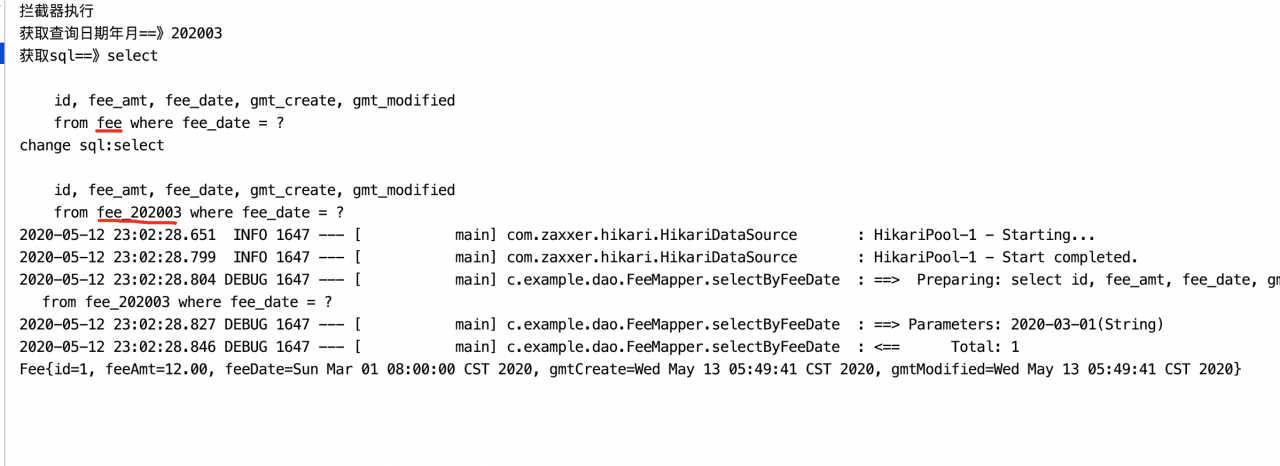水平分表(Mybatis插件实现)
tips:(这里可以根据实际业务进行选择,比如每个月数据不是很平均,就可以按照预算数据量来进行分割
例子,按照id mod 100 把表分成100张,然后进行表名+ (id mod 100)取 )
这里为了简单起见,假定月份数据量相差不大
将一张大表按照月份划分
fee_202001,fee_202002,fee_202003…
表中只有三个字段:id,费用金额fee_amt,费用日期fee_date
其中gmt_create,gmt_modified是阿里出的java泰山版表定义的规范
需要注意的是插件的注册,只需要在自定义插件上添加@Component,如果是Mybatis单独使用,则需要单独去注册,我这里是配合Spring
核心就在于拦截Executor,这里是只拦截了查询所以是 method添加的query 而且为了简单起见,并没有对缓存做特殊处理,也就是经过这个拦截器执行的开启了缓存也是没有效果的,如果想要生效,则去复写Exector中的另一个方法
核心类MyInterceptor
package com.example.interceptor;
import org.apache.ibatis.builder.StaticSqlSource;
import org.apache.ibatis.executor.Executor;
import org.apache.ibatis.mapping.BoundSql;
import org.apache.ibatis.mapping.MappedStatement;
import org.apache.ibatis.mapping.SqlSource;
import org.apache.ibatis.plugin.*;
import org.apache.ibatis.session.ResultHandler;
import org.apache.ibatis.session.RowBounds;
import org.springframework.stereotype.Component;
import java.lang.reflect.Field;
import java.util.Properties;
//Spring项目 添加Component注解 就是插件的注册
@Component
@Intercepts({@Signature(type = Executor.class,method = "query",
args = {MappedStatement.class, Object.class, RowBounds.class, ResultHandler.class})
})
public class MyInterceptor implements Interceptor {
@Override
public Object intercept(Invocation invocation) throws Throwable {
System.out.println("拦截器执行");
// 获取参数列表,就是上面注解配置的参数
Object[] args = invocation.getArgs();
// 获取ms
MappedStatement ms= (MappedStatement) args[0];
// 不是费用查询,继续往下执行
if(!ms.getId().endsWith("selectByFeeDate")) {
return invocation.proceed();
}
// 获取ms执行参数
String parameterObject = (String) args[1];
// 获取ms执行SQL语句
BoundSql boundSql = ms.getBoundSql(args[1]);
//获取查询日期年月
String yearAndMonth = parameterObject.replaceAll("-","").substring(0,6);
System.out.println("获取查询日期年月==》" + yearAndMonth);
/**
* 这里该使用正则匹配,且参数拼接需要校验,以防注入,给上默认值,防止查不到table
*/
// 替换查询表
String sql = boundSql.getSql();
System.out.println("获取sql==》" + sql);
sql = sql.replace("from fee ", "from fee_" + yearAndMonth + " ");
System.out.println("change sql:" + sql);
/**
* 替换 正要执行的(被我们处理过的sql语句)
*/
// 自定义sqlSource
SqlSource sqlSource = new StaticSqlSource(ms.getConfiguration(), sql, boundSql.getParameterMappings());
// 修改原来的sqlSource
Field field = MappedStatement.class.getDeclaredField("sqlSource");
field.setAccessible(true);
field.set(ms, sqlSource);
// 执行被拦截方法
return invocation.proceed();
}
@Override
public Object plugin(Object target) {
return Plugin.wrap(target,this);
}
@Override
public void setProperties(Properties properties) {
}
}
测试方法SpringbootMybatisApplicationTests
package com.example;
import com.example.dao.FeeMapper;
import com.example.dao.PersonMapper;
import com.example.entity.Fee;
import com.example.entity.Person;
import org.junit.jupiter.api.Test;
import org.mybatis.spring.annotation.MapperScan;
import org.springframework.beans.factory.annotation.Autowired;
import org.springframework.boot.test.context.SpringBootTest;
import java.util.ArrayList;
import java.util.List;
@SpringBootTest
@MapperScan("com.example.dao")
class SpringbootMybatisApplicationTests {
@Test
void contextLoads() {
}
@Autowired
private PersonMapper personMapper;
@Test
void testInsert(){
Person person = new Person();
person.setId(1);
List<Integer> list = new ArrayList<>();
list.add(1);
list.add(2);
list.add(3);
list.add(4);
person.setCheckBox(list);
personMapper.insert(person);
}
@Autowired
FeeMapper feeMapper;
@Test
void testQueryFeeByFeeDate(){
String feeDate = "2020-03-01";
Fee fee = feeMapper.selectByFeeDate(feeDate);
System.out.println(fee);
}
}
xml
<select id="selectByFeeDate" parameterType="string" resultMap="BaseResultMap">
select <include refid="Base_Column_List" /> from fee where fee_date = #{feeDate}
</select>
执行结果:
版权声明:本文为qq_35368565原创文章,遵循CC 4.0 BY-SA版权协议,转载请附上原文出处链接和本声明。